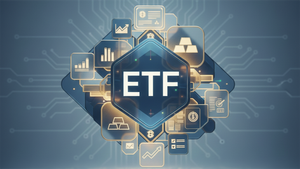The Simplify Barrier Income ETF (SBAR) and the Simplify Target 15 Distribution ETF (XV) capture equity volatility premia – making both funds a distinct source of returns that can complement a traditional equity allocation with defined barriers that allow investors to make quantifiable risk assessments
Simplify Asset Management (“Simplify”), a leading provider of Exchange Traded Funds (“ETFs”), today added two new funds to its already robust suite of income- and options-focused strategies with the launch of the Simplify Barrier Income ETF (SBAR) and the Simplify Target 15 Distribution ETF (XV).
Both strategies sell barrier put options based on the worst performing of three equity index ETFs representing US large cap, US small cap, and US growth stocks.
Premiums from selling these options are distributed to shareholders as income. The options sold by both funds are only exposed to downside if the worst performing of the three reference ETFs breaks below the barrier at the time of expiration. However, in the interim period prior to expiration, the funds’ prices will fluctuate up and down as the options are marked to current market prices. Both ETFs are also continuous products, meaning they hold a laddered portfolio of options that will continually be rolled, allowing the funds to be held for the long term.
The Simplify Barrier Income ETF (SBAR) offers a distinct source of monthly income by selling a laddered portfolio of 30-barrier put options. In exchange for accepting the risk of a loss defined by the 30-barrier level, investors can expect higher levels of income than can be found in traditional fixed income products. Unlike traditional bond or equity funds, the downside threshold for the underlying options is defined ahead of time, allowing investors to make an informed investment decision based on a quantifiable personal risk level.
The Simplify Target 15 Distribution ETF (XV) seeks to provide a 15% annualized distribution rate (paid monthly) by selling a laddered portfolio of barrier put options. The barriers are constantly adjusted to levels designed to support the fund’s 15% target distribution rate. Adding XV to a portfolio provides a source of potential income differentiated from traditional fixed income or volatility selling strategies.
“Our investors are continually seeking diversified sources of income,” said David Berns, CIO and Co-Founder of Simplify. “We are very excited to address this need with today’s launch of SBAR and XV as we continue our efforts to offer products designed to address the most pressing concerns in building today’s modern portfolios.”
For more on the Simplify Barrier Income ETF (SBAR) and the Simplify Target 15 Distribution ETF (XV), visit https://www.simplify.us/.
ABOUT SIMPLIFY ASSET MANAGEMENT INC
Simplify Asset Management Inc. is a Registered Investment Adviser founded in 2020 to help advisors tackle the most pressing portfolio challenges with an innovative set of options-based strategies. By accounting for real-world investor needs and market behavior, along with the non-linear power of options, our strategies allow for the tailored portfolio outcomes for which clients are looking. For more information, visit www.simplify.us.
DEFINITIONS:
Barrier Option: A type of customized over-the-counter option in which the underlying reference assets, tenor and barrier level are negotiated with a counterparty. They set a threshold (“barrier”) below which the underlying notional value is fully exposed to the downside upon expiration.
Option: An option is a contract that gives the buyer the right to either buy (in the case of a call option) or sell (in the case of a put option) an underlying asset at a pre-determined price ("strike") by a specific date ("expiry"). An "outright" is another name for a single option leg. A "spread" is when options are bought at one strike and an equal amount of options are sold at a different strike, all at the same expiry.
IMPORTANT INFORMATION:
Investors should carefully consider the investment objectives, risks, charges, and expenses of Exchange Traded Funds (ETFs) before investing. To obtain an ETF's prospectus or Summary prospectus containing this and other important information, please call (855) 772-8488, or visit SimplifyETFs.com. Please read the prospectus carefully before you invest.
An investment in the fund involves risk, including possible loss of principal.
The fund is actively-managed is subject to the risk that the strategy may not produce the intended results. The fund is new and has a limited operating history to evaluate. The Fund invests in ETFs (Exchange-Traded Funds) and entails higher expenses than if invested into the underlying ETF directly. The lower the credit quality, the more volatile performance will be. When junk bonds sell off, the lowest-rated bonds are typically hit hardest known as blow up risk. Likewise, the riskiest bonds typically rise fastest in a bull market however these investments that don't have a credit rating are typically the most volatile, hard to price and the least liquid.
The Fund invests in ETFs (Exchange-Traded Funds) and is therefore subject to the same risks as the underlying securities in which the ETF invests as well as entails higher expenses than if invested into the underlying ETF directly.
The use of derivative instruments involves risks different from, or possibly greater than, the risks associated with investing directly in securities and other traditional investments. These risks include (i) the risk that the counterparty to a derivative transaction may not fulfill its contractual obligations; (ii) risk of mispricing or improper valuation; and (iii) the risk that changes in the value of the derivative may not correlate perfectly with the underlying asset, rate, or index. Derivative prices are highly volatile and may fluctuate substantially during a short period of time. The use of leverage by the Fund, such as borrowing money to purchase securities or the use of options, will cause the Fund to incur additional expenses and magnify the Fund’s gains or losses. The Fund's investment in fixed income securities is subject to credit risk (the debtor may default) and prepayment risk (an obligation paid early) which could cause its share price and total return to be reduced. Typically, as interest rates rise the value of bond prices will decline and the fund could lose value.
While the option overlay is intended to improve the Fund’s performance, there is no guarantee that it will do so. Utilizing an option overlay strategy involves the risk that as the buyer of a put or call option, the Fund risks losing the entire premium invested in the option if the Fund does not exercise the option. Also, securities and options traded in over-the-counter markets may trade less frequently and in limited volumes and thus exhibit more volatility and liquidity risk.
Simplify ETFs are distributed by Foreside Financial Services, LLC. Foreside and Simplify are not related.
© 2025 Simplify ETFs. All rights reserved.
View source version on businesswire.com: https://www.businesswire.com/news/home/20250414881360/en/
Both strategies sell barrier put options based on the worst performing of three equity index ETFs representing US large cap, US small cap, and US growth stocks.
Contacts
Media Contact:
Rob Jesselson
Craft & Capital
rob@craftandcapital.com





